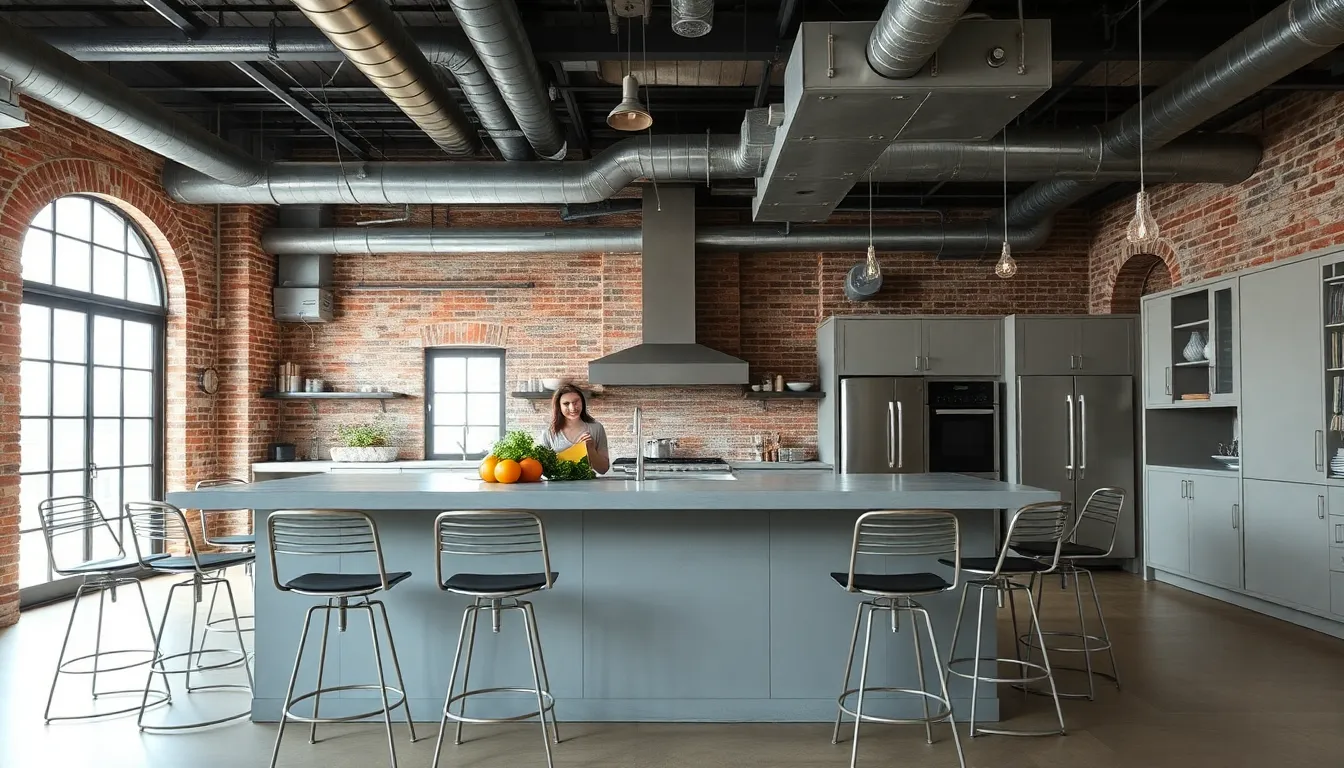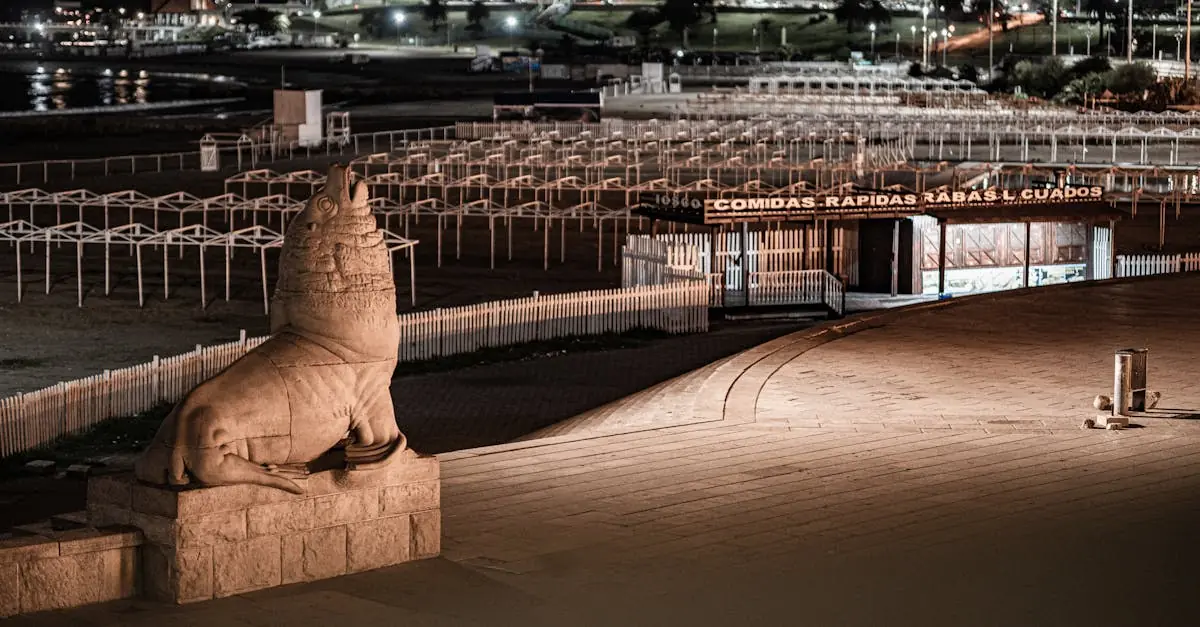Imagine stepping into a kitchen that feels like it belongs in a trendy New York loft rather than your suburban home. That’s the magic of industrial kitchen style. With its raw materials, exposed elements, and a dash of urban charm, this design trend transforms ordinary cooking spaces into culinary playgrounds.
Table of Contents
ToggleOverview of Industrial Kitchen Style
Industrial kitchen style merges functionality with edgy aesthetics. Raw materials, such as metals, wood, and concrete, dominate this look. Open shelving is common, allowing for easy access to kitchen essentials while displaying decorative items.
Exposed ductwork and pipes add to the rustic charm, embodying the unrefined essence typical of urban environments. Large windows often feature in these designs, enhancing natural light and creating an inviting atmosphere. Neutral color palettes, including grays, blacks, and whites, serve as a backdrop for bolder accents.
Lighting fixtures play a crucial role in setting the tone. Pendant lights with metal finishes complement the overall theme while offering practical illumination. Stainless steel appliances not only provide durability but also enhance the industrial feel.
Countertops feature raw materials like concrete or butcher block to maintain the theme. Bar stools with metal frames or reclaimed wood add seating options that blend practicality with style. Artistic touches, such as wall art and unique decor, personalize the space and enhance visual interest.
This style suits various kitchen layouts, from spacious interiors to smaller areas, providing adaptability. Mixing industrial elements with modern conveniences creates harmony without compromising function. Embracing this design trend transforms kitchens into vibrant, stylish spaces, reflecting contemporary urban life.
Key Features of Industrial Kitchen Style

Industrial kitchen style thrives on unique design elements and practical features. This approach prioritizes open spaces and raw finishes, creating a welcoming yet edgy environment.
Open Spaces and Layout
Open layouts define the industrial kitchen, emphasizing freedom of movement. Layouts often merge the kitchen with adjacent living areas, fostering interaction. Large islands serve as multifunctional workspaces, where cooking and socializing happen simultaneously. Minimalistic cabinetry creates a clean appearance, promoting spaciousness. Also, fewer barriers enhance the flow of light and air. This setup not only maximizes functionality but encourages a communal atmosphere.
Raw Materials and Finishes
Raw materials and finishes reinforce the industrial theme, establishing a rugged aesthetic. Concrete surfaces provide durability and a modern edge. Metal accents, including stainless steel appliances and fixtures, enhance the kitchen’s functionality and appeal. Natural wood elements add warmth, balancing sleek finishes. Exposed bricks or cement walls contribute to authentic charm, highlighting the unrefined beauty characteristic of industrial design. Incorporating these materials leads to a cohesive look that is both stylish and practical.
Color Palette
The color palette in industrial kitchen style showcases a blend of neutral and accent tones that create a striking visual appeal.
Neutral Tones
Neutral tones dominate the industrial kitchen’s color scheme. Shades like gray, beige, and taupe provide a versatile backdrop. These colors highlight the raw materials commonly used in the design. Walls painted in soft gray or warm beige create a calming atmosphere. Flooring in shades of concrete enhances the rugged aesthetic. Cabinets often feature unpainted wood or matte black finishes that maintain simplicity. The muted tones allow exposed pipes and metal fixtures to stand out, drawing attention to the architectural elements. Incorporating these neutral tones establishes a cohesive look that channels urban sophistication.
Accent Colors
Accent colors inject personality into the industrial kitchen space. Deep blues, forest greens, and rich burgundies serve as popular choices for pops of color. These hues can be introduced through accessories like dishware or textiles. A bold backsplash in deep blue can become a focal point. Art pieces with vibrant colors break up the neutral palette, providing visual interest. Bar stools in a striking hue can enhance seating areas while complementing the overall design. Choosing just a few accents keeps the space from feeling overwhelming. With careful selection, accent colors enhance the kitchen’s character without overshadowing its industrial charm.
Essential Elements of Industrial Kitchens
Industrial kitchens showcase distinct elements that combine functionality and aesthetic appeal. Important features contribute to creating a vibrant culinary environment.
Kitchen Islands
Kitchen islands serve as the focal points in industrial kitchens, often providing multifunctional spaces. These islands allow for cooking, dining, and socializing simultaneously. Materials like reclaimed wood or raw concrete enhance the rugged feel, maintaining the industrial theme. Large surfaces accommodate meal prep and can host multiple guests. Including seating options, such as metal-framed bar stools, transforms the island into an inviting gathering spot. This blend of style and practicality makes kitchen islands essential in fostering interaction and maximizing space.
Lighting Fixtures
Lighting fixtures significantly impact the ambiance of industrial kitchens. Pendant lights, often featuring metal finishes, add a striking visual element. These fixtures combine style with functionality, illuminating workspace effectively. Options like Edison bulbs complement the raw aesthetic while providing focused lighting. Sconces and track lighting can also be used to highlight specific areas, creating layered illumination. The right lighting enhances the kitchen’s overall design, reinforcing the industrial charm while ensuring practicality for everyday cooking tasks.
Tips for Achieving Industrial Kitchen Style
Creating an industrial kitchen involves blending raw elements with personalized touches. These tips offer guidance on how to achieve the desired aesthetic.
Sourcing Authentic Materials
Focus on selecting genuine materials that embody the industrial vibe. Reclaimed wood contributes warmth while showcasing character. Concrete countertops offer durability and a rustic appearance. Utilize metals like stainless steel for appliances and fixtures, enhancing functionality and style. Seek out suppliers specializing in industrial-grade materials for an authentic look. Industrial textures elevate kitchen aesthetics significantly, so incorporate elements like exposed brick or weathered finishes for a truly distinctive touch.
Blending with Modern Touches
Combine modern elements within an industrial framework to create a balanced aesthetic. Sleek, minimalist cabinetry provides contrast against raw textures, promoting a clean look. Incorporate contemporary lighting fixtures, such as geometric pendant lights, to add a stylish flair. Pair industrial dining tables with modern seating options to enhance versatility. Art pieces offer visual interest and personal expression while harmonizing with the rugged backdrop. By integrating these modern touches, the kitchen maintains its industrial charm while feeling fresh and inviting.
Embracing the industrial kitchen style brings a unique blend of functionality and aesthetic appeal to any home. Its raw materials and open layouts create a vibrant atmosphere that encourages both cooking and social interaction. The careful selection of colors and textures enhances the overall design while maintaining the rugged charm that defines this style.
By integrating modern elements with traditional industrial features, homeowners can achieve a balanced and inviting space. This adaptable design trend not only reflects contemporary urban life but also transforms ordinary kitchens into extraordinary culinary environments. With the right touches, an industrial kitchen can become a true focal point of the home, merging practicality with style in a way that inspires creativity and connection.







